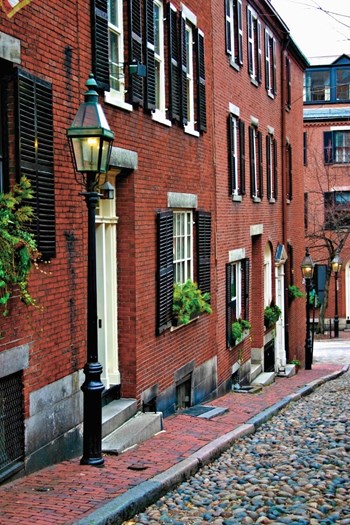
In a city known for its culture, colleges and universities, and above all, its historic role in the formation of our country, Boston contains an unusually high number of landmarked buildings. Many of these buildings are residential, and while living in them may have a certain cachet, maintaining, restoring and renovating them can be a longer and perhaps costlier enterprise.
Designated Districts
"The Boston Landmarks Commission (BLC) functions in conjunction with the local Historic District Commissions as the city's stewards of Boston's historic buildings, places and neighborhoods," according to the official website of the City of Boston. "There are more than 7,000 properties located within eight local Historic Districts designated as individual Boston Landmarks."
"The large ones are Beacon Hill, with about 1,200 buildings; Back Bay, which has over 2,000; and South End, which has about 3,500 buildings," says Ellen Lipsey, executive director of the Boston Landmarks Commission. "They are all brick row house districts, predominantly."
These major areas of landmarked buildings were designated in a couple of ways, says Lipsey. "Beacon Hill and Back Bay were determined by special acts of the Legislature. Beacon Hill, dating to 1955, is one of the two oldest historic districts in Massachusetts, with Nantucketand Back Bay dates from 1966. From that point on the districts were established under the Boston Landmarks Commission's enabling legislation."
Boston has a system in place whereby a district is designated as landmarked. To begin the landmarking process, a petition requesting landmark status must be submitted by a group of at least ten registeredvoters. Then, the mayor appoints a study committee to further examine the history and significance of the area, and to write architectural guidelines.
If the BLC accepts the petition for further study, a study committee is appointed. Then it goes to a hearing before the BLC. If the BLC votes for it, it goes to the mayor, who has 15 days to approve or deny it. Then it goes to the City Council and they have 30 days to approve or deny it. Finally, the mayor appoints the district's commission and then the process of review starts.
"Boston has individual guidelines for each district," explains Lipsey. "Once the districts are established, the mayor appoints individual commissions to meet once a month to do the design review for applicants. A homeowner or HOA would need to apply to the commission in most cases for anything that would be visible from a public way."
"Back Bay is different because it has distinctive alleys and anything is reviewedfrom every elevation, even rooftops," says Lipsey. "Generally, in the other districts, it is just from the public way."
The Review Process
Once a homeowner or HOA has plans to renovate or change a landmarked building, the approval from the Land-marks Commission can be handled in one of two ways, explains Lipsey. "People submit an application and depending on whether there are really visible design changes or minimal changes, this can either go to the commission, for items that will have a visual impact, or if it involves repairing something in kind, it could be a staff review."
Although the paperwork can be handled by several related parties (the contractor, the manager, the HOA, or the individual unit owner), the commission will look for a specific signature. "The application requires the signature of the owner," says Lipsey. "In the case of the condo, we want to make sure the signature has the authority to sign for multiple units. The main applicant could be the architect or contractor."
The best place to start the whole ball rolling is to go to the Buildings Depart-ment, which checks off on what is neededin the way of permits, says Lipsey. "They often start at the Inspectional Services Department, who is the largest enforcer of codes. They go through a checklist and that tells them where they need to go, including Landmarks and Historic District Commission."
Once referred to the Landmarks Commission, the next step is to submit an application. The deadline is two weeks prior to a hearing. "Planners assigned to each district will then determine whether something can be approvedadministratively or needs to go before the commission," says Lipsey. "If it is something like a flat roof and they are replacing it in kind, then something like that would not need to go to commission for review. If somebody put in a crummy front door at some point, for example, and they want to replace it with a nice wood front door—that kind of a design change may require a review. If somebody wanted to remove an original item, like an iron fence, or if somebody has an access issue, that requires a design change, and is something the commission would review."
This may sound a little daunting, but the system is in place and runs smoothly, in most cases, continues Lipsey. "It is generally a quick process, but people should know that they need to build in the time, knowing that the commission review is required, and they only meet once a month."
There are ways to expedite the process by doing a little research beforehand, addsLipsey. "Applicants can check with the district commissions for the particular dates and deadlines. They can also meet with the staff of the commission and determine whether what they want to do will be within the guidelines."
"In most cases we can receive a review two weeks before a hearing and have those determinations made at the hearing so that people can go to the buildingdepartment with their approval from the district commission, the Certificate of Applicability," says Lipsey.
Getting approved can be a little easier if the applicant knows what is expected, says Lipsey, and coordinating plans with precedents can assist the approval process. "The guidelines are listed on the website for different districts. They are set up by the history (largely architectural) and legacy of each district. Those guidelines apply for anyone living in that district."
Some things can be expected from the commission, continues Lipsey. "When the review goes to the commission, they are looking at the individual buildings, what type of windows does it have, what type of doors are there, etc…"
Although the review process may not add much in the way of additional costs, the recommendations may be another story, says Lipsey. "I'm sure other people would say that it is more expensive (to perform renovations on a landmarked building), because the commission is really looking for the original materials."
There are ways to save on costs, however, and the recommendations may reflect them, counters Lipsey. "If you have good wood windows that have been well maintained, they can probably still be repaired rather than replaced, and that could save you money. If an old house is maintained periodically it will last a lot longer than one that isn't."
Contractors
"People ask us about contractors," says Lipsey, "and I think one of the top frustrations of applicants [is] when they ask us for contractor names or suppliers, we can't recommend anyone. We do not make recommendations, but we will give people names of people who have worked in various districts."
"If they have a builders' license then they are licensed to perform work," says Lipsey. "They don't need any special certifications." It is always good to check with neighbors who have had work done for their recommendations, she says.
Although there are no special credentials for working on landmarked buildings, a good contractor will start carefully. "Thefirst and most obvious things are determining the protected areas of the structure and what can and cannot be done to those areas," says Fred Schernecker of SPS Inc., a Waltham, Massachusetts contracting firm.
Checking with the authorities may entail a few agencies, in addition to the Landmarks Commission, and contractors should make sure that the proper approvals have been applied for and given. "A property can be under the jurisdiction of any government authority,"continues Schernecker, "from the National Park Service for federally protected landmarks, all the way down to local cities and towns and their historic organizations."
Schernecker advises the help of a professional when attempting a major undertaking in a landmarked building. "It is a complex process to determine what and how it is protected. It would behoove whoever is trying to do the work to work with a consultant or someone who knows and is familiar with working with protected landmarks."
Maintenance Notes
There are some recommendations for those trying to maintain these structures while living in them, says Lipsey. "Well, I think for people living in masonry buildings, which includes most Boston multifamily buildings, repointing and certainly painting of any wood trim and elements will help."
"Brownstone is a somewhat fragile material, it will deteriorate," continuesLipsey. "That's one of those expenses that can really accelerate. People can check with neighbors or the commission to see what resources are available to work with people who specialize in that kind of repair. Stoops and fences that have been painted should be maintained. One of the biggest things to look out for is water infiltration: leaky windows, flashing on the roof, or on the parapet walls. Repointing, chimneys and rooftops, gutters…. It's all the stuff that as homeowners all of us never get around to, but should."






Leave a Comment